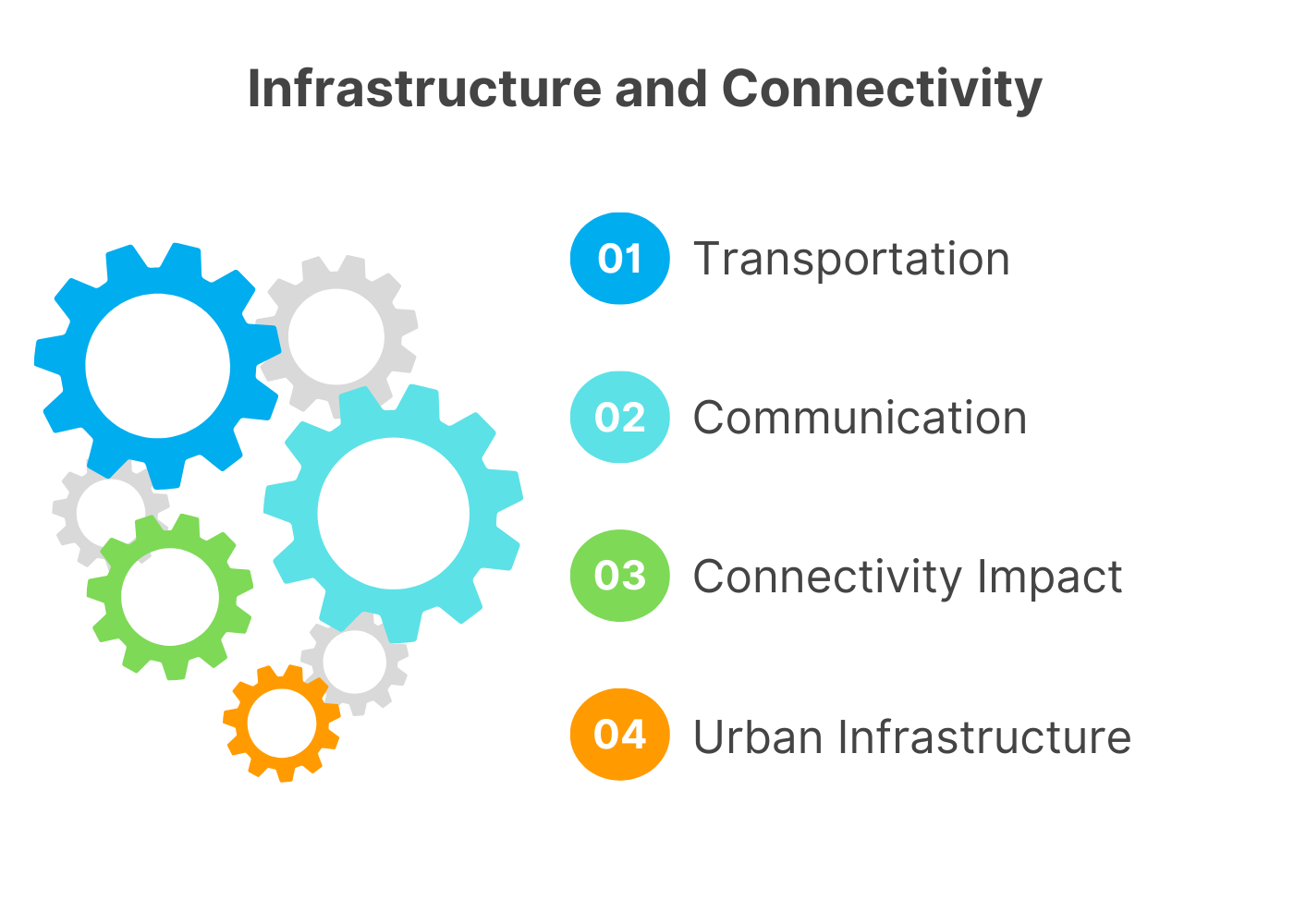Detailed content
Introduction
Infrastructure and connectivity play pivotal roles in shaping the
physical and human landscapes of our planet. From ancient trade
routes to modern transportation networks, infrastructure
facilitates the movement of people, goods, and ideas across space.
In this comprehensive overview, we will delve into the various
aspects of infrastructure and connectivity in geography, examining
their historical significance, spatial patterns, environmental
impacts, and future prospects.
Historical Perspectives
• The development of infrastructure and connectivity has been
intertwined with human history since the dawn of civilization.
Early societies constructed roads, bridges, and waterways to
facilitate trade and travel, laying the groundwork for regional
and global networks of exchange. The Silk Road, for example,
connected China with the Mediterranean world, fostering cultural
exchange and economic growth across vast distances.
• During the
industrial revolution, advancements in technology revolutionized
transportation and communication, leading to the construction of
railways, canals, and telegraph lines. These innovations
accelerated urbanization and industrialization, as people and
goods could move more efficiently than ever before. In the 20th
century, the rise of automobiles, airplanes, and
telecommunications further transformed the global landscape,
shrinking distances and expanding opportunities for
interaction.
Spatial Patterns
• Infrastructure and connectivity exhibit distinct spatial patterns
influenced by geographical factors such as topography, resources,
and population distribution. In densely populated regions,
transportation networks tend to be more extensive, with highways,
railways, and airports linking urban centers and industrial hubs.
Coastal areas often boast busy ports and shipping lanes, serving
as gateways for international trade and commerce.
• In contrast,
remote and mountainous regions may have limited infrastructure due
to rugged terrain and low population densities. Indigenous
communities in these areas often face challenges accessing
essential services such as healthcare and education, highlighting
the uneven distribution of infrastructure on a global scale.
However, initiatives such as rural electrification and satellite
internet are gradually bridging the gap, bringing connectivity to
even the most isolated regions.
Environmental Impacts
• While infrastructure and connectivity have undeniable benefits,
they can also have significant environmental impacts, including
habitat destruction, pollution, and climate change. The
construction of highways, dams, and pipelines can fragment
ecosystems, disrupt wildlife habitats, and alter natural drainage
patterns, leading to biodiversity loss and soil erosion.
Similarly, the burning of fossil fuels for transportation and
energy production contributes to air and water pollution,
exacerbating respiratory diseases and ecosystem degradation.
• Moreover, infrastructure projects such as dams and irrigation
systems can exacerbate water scarcity by altering the natural flow
of rivers and depleting groundwater reserves. In coastal areas,
the development of ports and marinas can disrupt marine
ecosystems, threatening coral reefs and fisheries. Addressing
these environmental challenges requires a holistic approach that
balances the need for infrastructure development with ecological
conservation and sustainable resource management.
Future Prospects
• As we look to the future, the role of infrastructure and
connectivity in shaping our planet will only become more
pronounced. Rapid urbanization, population growth, and
technological innovation will drive demand for new transportation
networks, energy systems, and digital infrastructure. Emerging
technologies such as autonomous vehicles, renewable energy, and 5G
networks have the potential to revolutionize how we live, work,
and travel.
• At the same time, climate change poses unprecedented
challenges to existing infrastructure, as rising sea levels,
extreme weather events, and resource scarcity threaten the
resilience of built environments. Adapting to these challenges
will require investment in climate-resilient infrastructure, green
technologies, and sustainable land-use planning. Moreover,
fostering international cooperation and partnerships will be
essential to address global issues such as energy security,
cybersecurity, and digital divide.
• In conclusion, infrastructure
and connectivity are fundamental drivers of spatial dynamics and
human interactions on our planet. From ancient trade routes to
futuristic smart cities, the evolution of infrastructure reflects
the ingenuity and adaptability of human societies in shaping their
environments. By embracing innovation, sustainability, and
inclusivity, we can build a more connected and resilient world for
generations to come.
Conclusion
• In this comprehensive overview, we have explored the multifaceted role of infrastructure and connectivity in geography. From historical trade routes to modern transportation networks, infrastructure shapes the spatial dynamics of human societies and ecosystems. While offering opportunities for economic growth and social development, infrastructure also poses environmental challenges that must be addressed through sustainable planning and management. Looking ahead, the future of infrastructure and connectivity will be shaped by technological innovation, climate change, and global cooperation. By investing in resilient, inclusive, and sustainable infrastructure, we can build a more connected and prosperous world for all.
